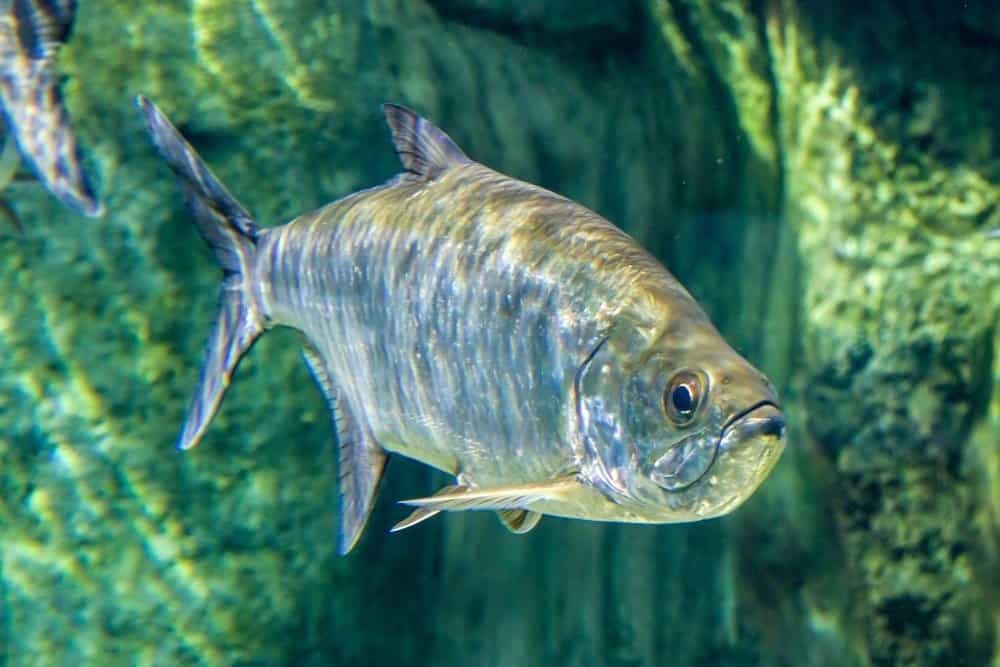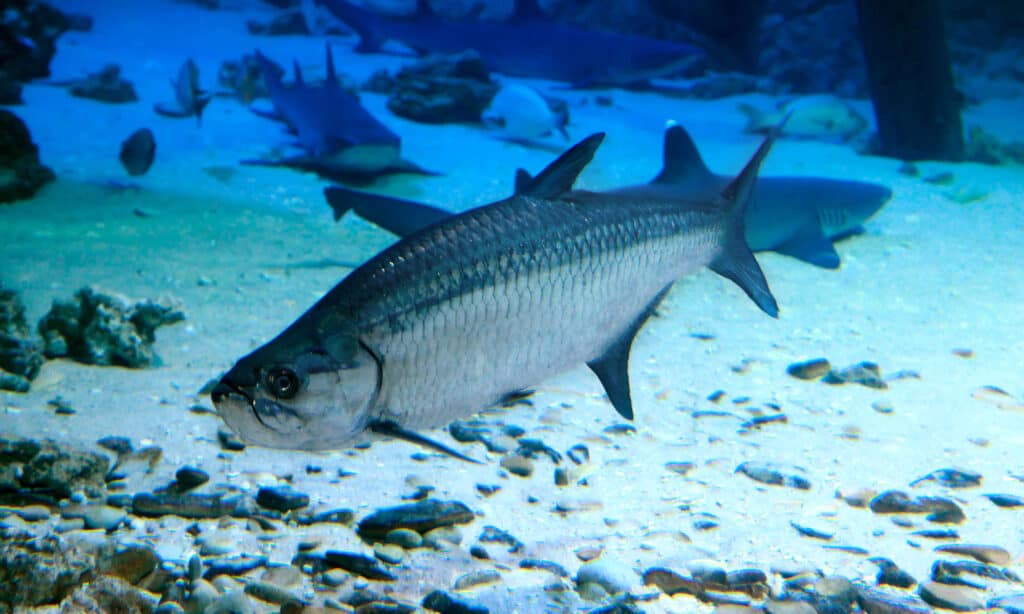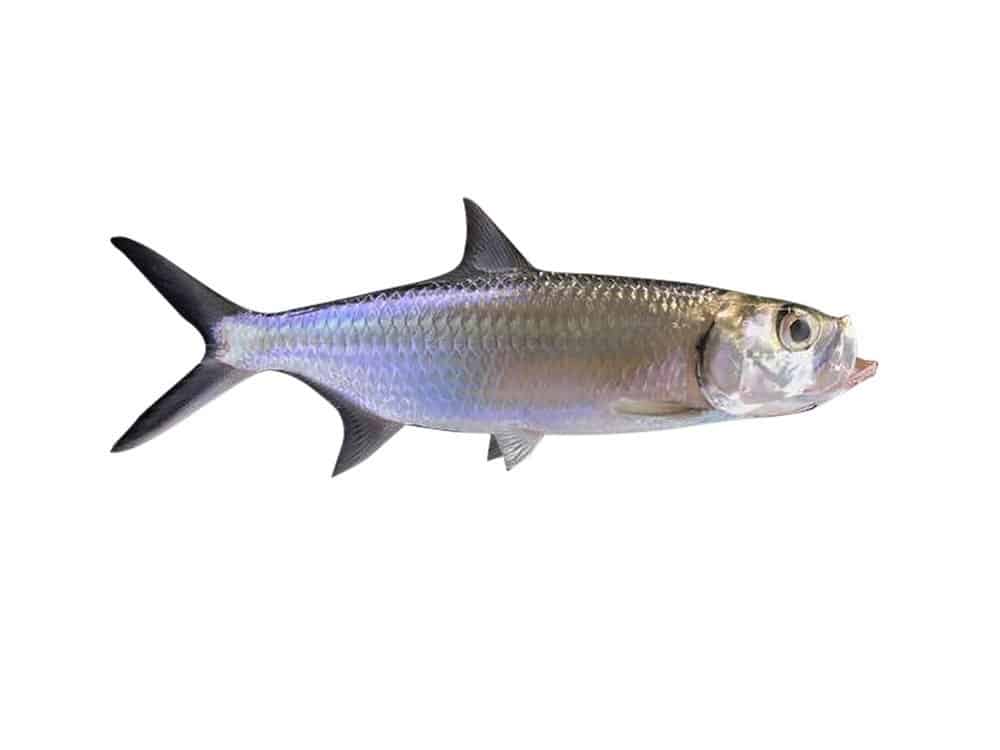Tarpons are large fish from the genus Megalops and they are native to the Atlantic and the Indo-Pacific oceans. Nicknamed the “silver king”, tarpons have shiny, silver scales and are one of the greatest sport fishes around. They are renowned for their acrobatic displays and impressive jumps as well as their great size. However, it’s not only their athletic ability that makes them unique, but their teeth as well. Tarpons are unusual as they begin their life in a larvae state, and their teeth are completely different to what they are as adults. Join us as we dive into all the fascinating facts about tarpon teeth.
The Big Fish with the Tiny Teeth

Despite their size, tarpon have really tiny teeth
©Danny Ye/Shutterstock.com
As you might expect from a fish that is held in high esteem by sport fishermen, tarpons are particularly large. Females are much larger than males and the heaviest recorded tarpons all well exceed 200 pounds and can easily reach 8 feet in length. Therefore, it probably comes as quite a surprise that, despite their size, tarpons actually only have really small teeth.
Tarpons have rows of small, densely packed teeth all over their mouth – including their jaw and tongue – which are known as “villiform”. These teeth are small, pointy, and needle-like. Although they have many of these tiny teeth, tarpons not dangerous. A bite from a tarpon is often described as feeling like nothing more than rough sandpaper across the hand and is rarely ever serious.
Tarpons have a unique structure and their lower jaw is large and protruding which gives it an upturned appearance. Their mouth is wide and gaping which allows plenty of room for their teeth. As well as having lots of small teeth, tarpons have a bony plate on the upturned part of their lower jaw which helps them to crush some of their prey. However, they generally just swallow their prey whole as their teeth are too small to be of any use to them. Tarpons are strict carnivores and feed on fish such as sardines, anchovies, catfish, and pinfish. They also sometimes eat crabs and shrimp. Their main predators are bull sharks, great hammerheads, alligators, porpoises, and us humans.
Tarpon Teeth in the Larvae Phase

Tarpon spend their early life as larvae
©iStock.com/TatianaMironenko
Although tarpons end up impressively large, they begin life as tiny larvae, and their teeth are pretty unusual during this phase. One of the most fascinating things about the reproduction of tarpons is that the lunar cycle influences when they spawn. Female tarpons lay up to 12 million eggs at once far off shore. Hatchings then occur a few days later – within one week of the new moon – and the larvae phase begins.
The larvae phase is known as leptocephalus and tarpon larvae closely resembles the larvae of eels. Tarpon larvae are transparent, slender, and are shaped like ribbons. During the first stage of the larvae phase they grow to around 1.1 inches long over a period of 2 to 3 months. However, at the beginning the only resemblance to adult tarpon is their forked tail fin. During this phase, tarpon larvae have very low energy requirements. This makes them particularly unique as they swim around but rarely eat. Throughout leptocephalus, tarpon larvae have minuscule teeth which point outwards. This unique structure acts as a guard or a filter and prevents anything from entering their mouth. Towards the end of the first stage, their bodies thicken and the shape of their head gradually changes.
During the next stage, the tarpon larvae actually shrinks to 0.5 inches although at this point their teeth are no longer pointing outwards. This stage lasts around three weeks before they enter the final larval stage. During the third stage they grow to 1.5 inches over a period of 7 to 8 weeks. At this point their fins develop and their bodies change shape to resemble adult tarpons. Their lower jaw extends forward while their teeth become the villiform formation that they have throughout their lives.
Juvenile Tarpons

Juvenile tarpon live in nursery lagoons
©kyaranani/Shutterstock.com
In the final development stage, tarpons have transformed from larvae and are now known as juveniles. Juvenile tarpons swim inshore and congregate in lagoons which act as nurseries. These lagoons are generally free from larger predators such as sharks, which means that the young tarpons can thrive. Even though the lagoons are often somewhat lacking in oxygen, it doesn’t affect the tarpons. This is because they have the unique ability of being able to gulp air with their mouth as well. They can do this because they have a modified swim bladder which is directly connected to their esophagus. This allows them to gulp air and fill their swim bladder that way. Tarpon are able to breathe using this method and their gills interchangeably.
Throughout the final larval stages, tarpons began to feed on small fish once their teeth transformed from their early state. As juveniles, tarpons continue to feed on small fish such as guppies, killifish, and finger mullet. They remain in the lagoons until adulthood is reached at around three years old, at which point they begin to feed on bigger fish.
Tarpons have been Around for a Really Long Time
For a fish that’s so popular, it might be strange to think that tarpons have actually been around for a really, really long time. Tarpons are the most primitive of the bony fishes. Early tarpons shared the ocean with prehistoric fish during the early Cretaceous period around 113 million years ago. To put that into perspective – the infamous T-Rex didn’t appear until the late Cretaceous (90 to 66 million years ago).
Fossil records show that the earliest tarpons had larger teeth and were incredibly good predators. However, the transformation into the tarpons we see today was complete around 18 million years ago. This means that evolution of the tarpons stopped and they have survived in their current form since then!
The photo featured at the top of this post is © Brian Lasenby/Shutterstock.com
Thank you for reading! Have some feedback for us? Contact the AZ Animals editorial team.






